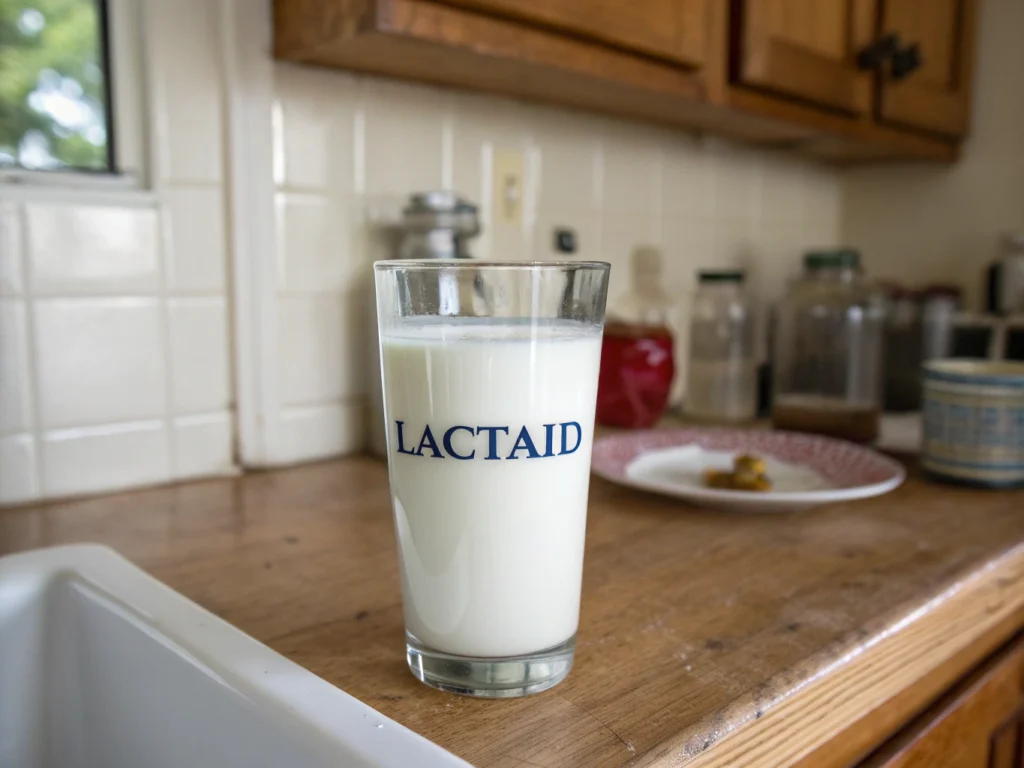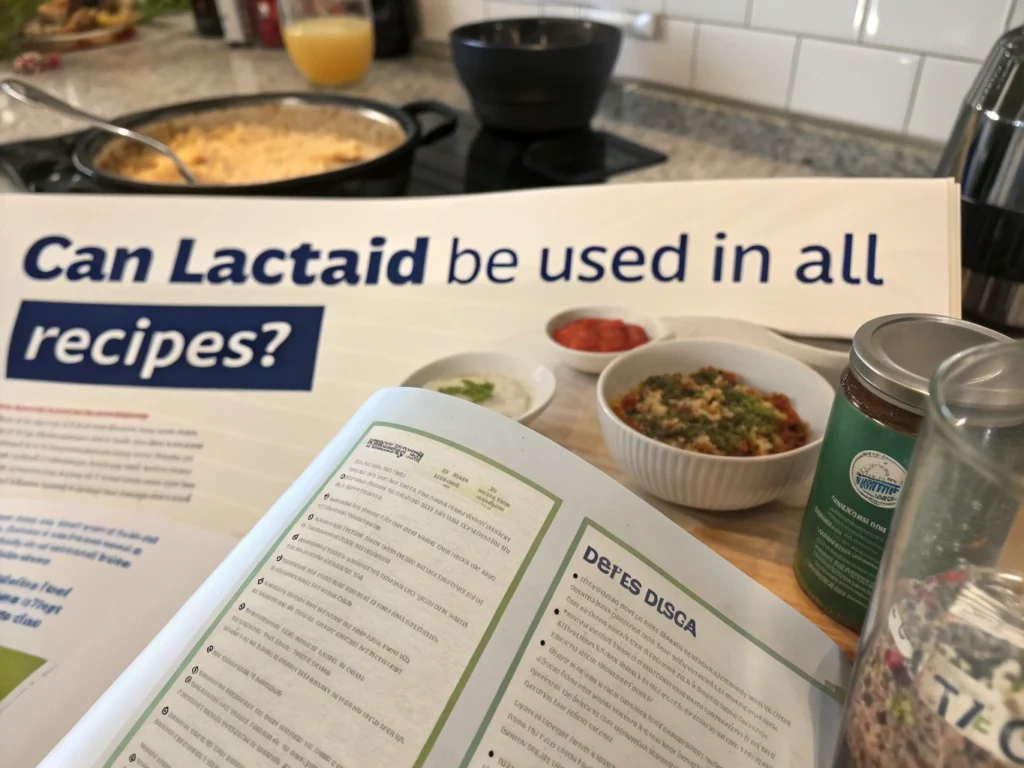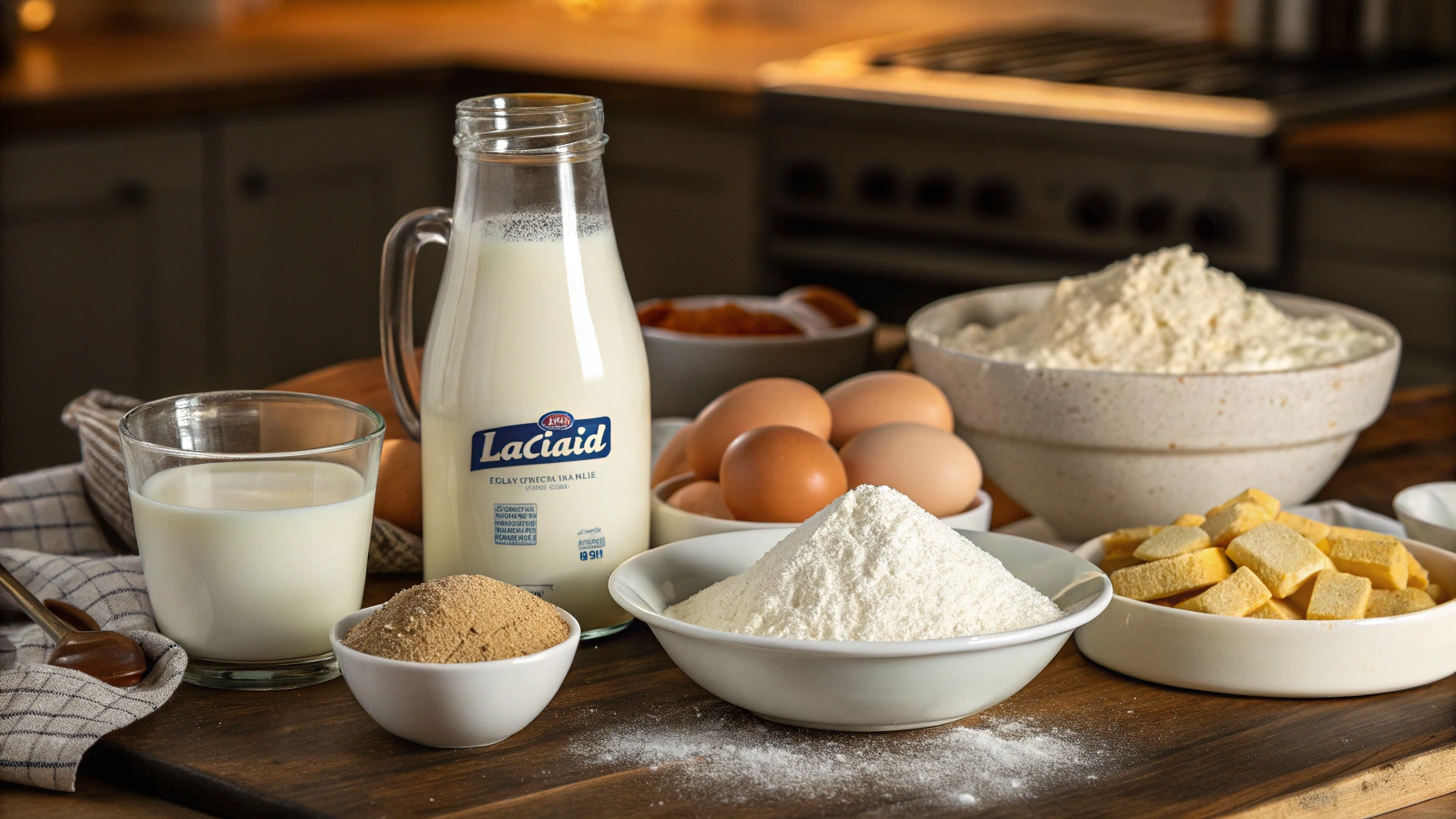Lactose intolerance shouldn’t keep you from enjoying your favorite dishes. Thankfully, alternatives like LACTAID milk offer a lactose-free option that’s still rich in nutrients and flavor. But what about its versatility? Can LACTAID seamlessly replace regular milk in recipes without compromising texture or taste? This article explores the ins and outs of cooking and baking with LACTAID, offering practical tips, benefits, and potential challenges. Whether you’re crafting a savory sauce or whipping up baked goods, this guide will help you navigate the world of LACTAID substitutes. Let’s dive in.

Understanding LACTAID as a Milk Substitute
What is LACTAID Milk?
LACTAID milk is a lactose-free dairy product specially designed for individuals with lactose intolerance. It’s made by adding lactase, the enzyme that breaks down lactose, to regular milk. This process makes it easier to digest while retaining the familiar creamy texture and taste of traditional milk. Unlike plant-based alternatives, LACTAID is derived from cow’s milk, ensuring it delivers the same nutritional benefits, including calcium and vitamin D.
Why Choose LACTAID?
Choosing LACTAID isn’t just about avoiding lactose—it’s about enjoying dairy without discomfort. For those who miss the creamy richness of regular milk, LACTAID offers a nearly identical experience, making it a go-to choice for many recipes. Its natural sweetness, derived from the enzymatic breakdown of lactose, can even enhance certain dishes. Plus, it’s versatile enough to work in both hot and cold applications.
Nutritional Profile of LACTAID
Nutritionally, LACTAID milk is on par with regular milk. It’s packed with essential nutrients like protein, calcium, and potassium, making it a healthier choice than many non-dairy alternatives. Additionally, it contains no added sugar, contrary to popular belief—the slight sweetness comes from the lactose conversion process. This nutritional similarity ensures that substituting LACTAID won’t compromise the health benefits of your recipes.
Cooking and Baking with LACTAID
Can LACTAID Be Used in All Recipes?

If you’re wondering, can you use LACTAID instead of milk in recipes? The answer is almost always yes! LACTAID milk works well in most recipes where regular milk is called for, thanks to its similar consistency and flavor. From creamy soups to decadent desserts, it blends seamlessly without any noticeable differences. However, there are a few exceptions—recipes that rely on the specific properties of milk proteins, such as cheese-making, may need extra tweaks.
When using LACTAID, it’s important to note its slightly sweeter taste compared to regular milk. This natural sweetness, while mild, can enhance desserts like puddings or custards. But for savory dishes, you may want to adjust other seasonings to balance flavors.
Substituting LACTAID in Baking
Baking with LACTAID is a breeze. Whether you’re whipping up cookies, muffins, or cakes, this lactose-free option performs almost identically to regular milk. Its creamy consistency ensures that batters remain smooth, and it doesn’t alter the texture of baked goods. If a recipe calls for buttermilk, you can even use LACTAID by adding a splash of vinegar or lemon juice to mimic the acidity.
For those concerned about browning or caramelization, rest assured—LACTAID behaves just like milk in the oven. The natural sugars in the milk contribute to that golden-brown finish we all love in baked goods.
Cooking Savory Dishes with LACTAID

From hearty soups to creamy pastas, LACTAID milk is a fantastic option for savory recipes. It won’t curdle under heat, making it ideal for dishes like chowders or béchamel sauces. Its ability to hold up under high temperatures ensures a smooth, velvety consistency in sauces and gravies.
One tip to keep in mind: since LACTAID is naturally sweeter, you might want to reduce any added sugar or balance it with extra salt or spices, depending on the dish. This subtle adjustment will help preserve the intended flavor profile of your recipe.
Benefits and Challenges of Using LACTAID in Recipes
Benefits of LACTAID Over Regular Milk
One of the biggest advantages of using LACTAID milk is its digestibility. For those with lactose intolerance, it eliminates the discomfort of bloating and indigestion without sacrificing the taste and texture of traditional milk. Additionally, its nutritional value mirrors that of regular milk, ensuring you’re not missing out on essential nutrients like calcium or vitamin D.
Another perk? Its slightly sweet flavor can enhance desserts, making them taste richer without extra sugar. Plus, it’s available in a variety of fat levels—whole, reduced-fat, and fat-free—so you can choose the one that best suits your recipe.
Potential Challenges
Despite its many benefits, there are a few challenges when using LACTAID in recipes. The natural sweetness of LACTAID may not work perfectly in recipes that rely on the neutral taste of regular milk. For example, dishes like savory cheese sauces or soups may require a little extra seasoning to mask the sweetness.
Additionally, while LACTAID works well for most recipes, some specialized cooking techniques, such as frothing milk for lattes or making certain dairy-based sauces, may yield slightly different results. Understanding these nuances will help you get the most out of your LACTAID substitutions.
Using LACTAID milk in cooking and baking offers numerous benefits with only minor adjustments needed for specific recipes. It’s a versatile option for anyone wondering, can you use LACTAID instead of milk in recipes? With a little know-how, you’ll be creating delicious, lactose-free dishes in no time. Next, we’ll dive into expert tips for ensuring success with LACTAID.
Tips for Using LACTAID in Recipes
Best Practices for Baking with LACTAID
When it comes to baking, using LACTAID milk requires minimal adjustments. Its creamy texture and natural sweetness make it a seamless substitute for regular milk in recipes like muffins, cakes, and bread. However, to get the best results:
- Use the same amount of LACTAID milk as regular milk.
- For buttermilk-based recipes, mix a tablespoon of vinegar or lemon juice per cup of LACTAID to mimic the acidity.
- Ensure all ingredients are at room temperature to prevent curdling or texture changes.
These small tweaks ensure that your baked goods maintain their desired flavor and consistency.
Adapting Recipes for LACTAID
While LACTAID milk is versatile, a few adjustments can make it even better for specific recipes. For instance:
Bonus Tip: If you love desserts, check out this cream cheese white chocolate pudding recipe for inspiration!
FAQs About Using LACTAID in Recipes
Can You Use LACTAID Instead of Milk in Recipes?
Yes, you absolutely can! Whether it’s for baking or cooking, LACTAID milk works just like regular milk in most recipes. Its lactose-free nature makes it a lifesaver for those with lactose intolerance while keeping dishes creamy and delicious.
Does LACTAID Affect Cooking Time?
Not at all. LACTAID milk heats, blends, and bakes at the same rate as regular milk. The only thing to keep in mind is its slightly sweeter flavor, which might require minor adjustments in seasoning or sugar levels.
Can LACTAID Replace Milk in Vegan Recipes?
No, since LACTAID milk is derived from cow’s milk, it’s not suitable for vegan diets. However, it’s an excellent option for anyone looking for a dairy-based alternative without the lactose.
For more lactose-free recipe ideas, consider visiting DeliciouRecipes’ Instant Pudding Guide, which highlights the versatility of LACTAID milk in desserts.
Conclusion: Is LACTAID a Perfect Milk Substitute?
Final Thoughts on LACTAID’s Versatility
If you’ve been asking, can you use LACTAID instead of milk in recipes? the answer is a resounding yes! From savory soups to delicate desserts, LACTAID milk proves itself as a versatile substitute for regular milk. Its lactose-free formulation makes it a go-to option for those with dietary restrictions, while its taste and consistency closely mimic traditional dairy.
Of course, there are some considerations. Recipes that depend heavily on the neutral flavor of regular milk, such as cheese sauces or savory bread puddings, may need slight adjustments. Yet, for most everyday cooking and baking, LACTAID performs flawlessly.
Who Should Use LACTAID in Recipes?
LACTAID milk is ideal for anyone seeking a lactose-free solution without sacrificing flavor or nutrition. It’s especially beneficial for families with diverse dietary needs or anyone eager to experiment with healthier alternatives. Whether you’re crafting comfort food or an elegant dinner party dish, LACTAID fits the bill.
Additional Resources and Recipe Inspiration
Where to Find More Ideas
If you’re still wondering can you use LACTAID instead of milk in recipes?, there’s no better way to find out than experimenting with tried-and-true dishes. For inspiration, explore resources dedicated to lactose-free cooking. Websites like DeliciouRecipes provide a wealth of ideas to get you started, including dishes perfect for every occasion. From creamy desserts to savory main courses, there’s no shortage of recipes to explore.
For a quick dessert fix, try their cream cheese white chocolate pudding recipe, which showcases how LACTAID milk performs in sweet, indulgent treats. Similarly, their instant pudding guide is a must-read for anyone looking to make quick, delicious desserts using lactose-free milk.
Cooking Beyond Desserts
While desserts often get the spotlight, LACTAID milk is equally impressive in savory recipes. Think creamy soups, velvety mashed potatoes, or rich pasta sauces. Websites like DeliciouRecipes provide versatile meal ideas that highlight how easily LACTAID can replace regular milk. For example, try adapting your favorite soup recipe by substituting LACTAID milk—its smooth consistency and mild sweetness will elevate the flavors.
Another idea? Create a creamy alfredo sauce using LACTAID milk. Simply combine butter, garlic, LACTAID milk, and Parmesan cheese to craft a restaurant-quality dish at home. It’s proof that LACTAID isn’t just for sweets—it’s a versatile ingredient for all types of cuisine.
Tips for Finding Recipes That Use LACTAID
Looking for recipes tailored to lactose-free cooking? Start with simple keyword searches like “lactose-free desserts” or “recipes with LACTAID milk.” These searches often lead to blogs, recipe collections, or culinary websites that specialize in lactose-free ingredients. Bookmark your favorites and build a library of go-to recipes for future use.
Additionally, don’t shy away from modifying your own family recipes. If a dish calls for milk, simply swap it out for LACTAID milk in equal proportions. For those nervous about experimenting, start with simpler dishes like pancakes or scrambled eggs before moving on to more complex meals.
Wrapping It All Up
Whether you’re baking sweet treats or crafting comforting meals, LACTAID milk is a fantastic addition to your kitchen. Its versatility makes it suitable for nearly any dish that calls for regular milk, giving you the freedom to cook and bake without worrying about lactose. Still asking yourself, can you use LACTAID instead of milk in recipes? The answer is clear: you can, and it’s an easy way to create delicious, lactose-free meals.
So why wait? Grab a recipe, make the swap, and enjoy the rich, creamy results. If you’re in need of more inspiration, don’t forget to visit trusted recipe sites like DeliciouRecipes for guidance. With a little creativity, you’ll find that cooking with LACTAID milk is not only simple but also incredibly rewarding. Happy cooking!
More Ways to Incorporate LACTAID in Everyday Cooking
If you’re excited about using LACTAID milk but want even more ideas for incorporating it into your daily meals, there are countless options to explore. Breakfast is a great place to start—use LACTAID milk in your favorite pancake or waffle recipe for a fluffy, light texture. Pair those with a creamy latte made with steamed LACTAID milk for a morning treat that feels indulgent yet digestible.
For lunch, why not try a lactose-free spin on creamy tomato soup? Simply blend roasted tomatoes with garlic, onion, and LACTAID milk for a silky, comforting bowl of soup. This pairs perfectly with a grilled cheese sandwich, made with your choice of lactose-free cheese.
Dinner offers even more opportunities to experiment. LACTAID milk works wonderfully in casseroles, like a classic baked macaroni and cheese. The milk’s smooth texture binds the ingredients together, while its mild sweetness complements the rich, cheesy flavor. If you’re a fan of international cuisine, consider using LACTAID milk in curries or cream-based sauces, where its ability to withstand heat without curdling really shines.
Expanding Your Recipe Repertoire
If you’re new to lactose-free cooking, don’t hesitate to branch out and explore recipes you may not have considered before. Try baking a classic French quiche with a LACTAID milk twist—its creamy consistency ensures a custard-like filling that pairs beautifully with a crisp, buttery crust. Alternatively, dive into the world of homemade bread by substituting LACTAID milk in any recipe that calls for milk. You’ll find that it enhances the dough’s softness while maintaining the flavor you love.
For dessert, consider crafting a batch of lactose-free ice cream. By combining LACTAID milk with sugar, egg yolks, and your favorite flavorings—like vanilla or chocolate—you can enjoy a creamy treat without worrying about lactose. The natural sweetness of LACTAID milk makes it an ideal base for frozen desserts.
Inspiration for Every Season
Cooking with LACTAID milk isn’t limited to specific seasons. In the summer, use it to make refreshing milkshakes or smoothies. Blend LACTAID milk with fresh fruit and a touch of honey for a nourishing drink that’s perfect for warm weather. During the colder months, it’s great for rich, creamy hot chocolate or festive eggnog.
For holiday gatherings, dishes made with LACTAID milk can cater to a crowd with diverse dietary needs. Imagine serving a lactose-free pumpkin pie or mashed potatoes made creamy with LACTAID. These dishes ensure that everyone at the table can enjoy the meal without missing out on their favorites.
Final Thoughts on Cooking with LACTAID
Using LACTAID milk in your recipes is a simple yet effective way to adapt to lactose intolerance without giving up the foods you love. Whether you’re a seasoned home cook or just starting out, this versatile ingredient opens the door to endless culinary possibilities. As you continue to explore, you’ll find that the answer to the question can you use LACTAID instead of milk in recipes? is a confident yes—and it’s easier than you might think.
So grab your apron, stock up on LACTAID milk, and start experimenting with new recipes. Your kitchen adventures are about to get a whole lot creamier and a lot more fun. Happy cooking!


